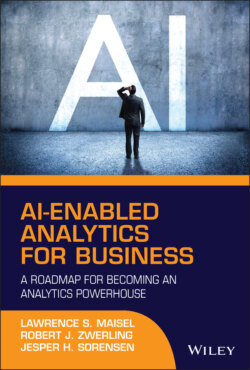Читать книгу AI-Enabled Analytics for Business - Lawrence S. Maisel - Страница 11
MACHINE LEARNING PRIMER
ОглавлениеThis section offers a brief orientation to ML. ML is a technique and technology that today requires specialized skills to use and deploy. ML is an AI engine often used with other tools to render the ML output useful for decisions. For example, suppose a bank wants to expand the number of loans without increasing the risk profile of its loan portfolio. ML can be used to make predictions regarding risk, and then the results are imported to spreadsheets to report those new additional loan applicants that can now be approved.
Large ML projects often involve the collaboration of data scientists, programmers, database administrators, and application developers (to render a deliverable outcome). Further, ML needs large volumes of high-quality data to “train” the ML model, and it is this data requirement that causes 8 of 10 ML and AI projects to stall.4 While ML is popular and powerful, it is not easy. Many new software applications are making ML use easier, but it is still mostly for data scientists.
Before an ML project can begin, its “object” must be defined: that is, what is to be solved. For example, suppose we want to predict which customers on our ecommerce website will proceed to check out (vs. those who exit before checking out). As presented in Figure 1.2, the process to go from the object to deployed solution has many steps, including collection of data, preparation of data, selecting the algorithm and its programming, model training, model testing, and deployment. Any failure at any point will require a reset and/or restart back to any previous point in the process.3
Figure 1.2 ML process.
ML has a limitation in that the solution of the object is highly specific to the data used to train the ML model. Most often, the model is not transportable, even to a similar business or a similar department within the same business. Also, as mentioned, the use of ML often requires other tools to render its results useful for consumption by business managers. However, while complex, ML can offer high business value with a wide range of applications: for example, predicting customer churn, sales deals that will close in the next 60 days, drugs that are likely to proceed to the next phase in trials, customers who are more likely to buy with a 5% discount, demand forecasting, and so on.
